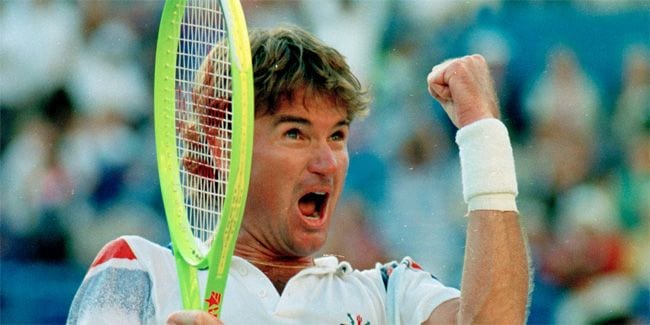
“In every great story there is conflict, and such was the essence of Connors’ charm. “
— Bruce Jenkins, “Twenty years later, Connors’ 1991 Open run remains awe-inspiring.”
“I was an asshole?” Jimmy Connors looks rather like an asshole when he asks this of his interviewer. Seated in a comfy chair in an elegant drawing room, with conventionally masculine décor (wooden, neat, with trophies on shelves), he makes his eyes wide and his face vague. Whether he means to emphasize the rhetorical nature of his question or look surprised, he makes a good show here, much as he’s done throughout his career as a tennis player.
Connors’ showmanship is the focus of This is What They Want, the latest entry in ESPN’s 30 for 30 series, in particular the remarkable performance he managed for the 1991 US Open. He was old at the time, 38, a point noted more than once by announcers and interviewees as they offer their versions of what happened. The record of play is plain enough: he was ranked 174th as he entered the stadium at Flushing Meadows that August. Everyone knew he was finished, everyone but Connors. He went on to defeat one opponent after another, beginning with Patrick McEnroe in the first round, and including Michiel Schapers and Karel Novacek as well as Aaron Krickstein, with whom he did long and brutal battle on Connors’ 39th birthday.
“I don’t apologize for anything,” says Connors, “Not now, never.” Before Connors, Brian Kppleman and David Levien’s film proposes, tennis had been a gentleman’s game, a “weenie game.” According to Mary Carrillo, “I believe that in my bones that he changed the perception of tennis.” Okay, so maybe she’s a bit too earnest, but the idea is not hers alone. A series of subjects concur: the transformation driven by Connors had to do with speed and strength, and also with identity, with the way the sport was perceived. Howard Bryant poses the question that others asked for years: “Why is he always getting in trouble?” But that background made for great backstory when, in 1991, he made a last run at the US Open, embodying what Bryant calls “one of the great narratives that we love in sports.”
The start to that narrative is familiar: Connors was from “the wrong side of the tracks,” born in East St. Louis in 1952, a player no one expected to see. His early triumphs were peppered with controversy — he refused to join the just started union, the Association of Tennis Professionals (ATP) in 1972. Following, he won his first Pro Singles title in 1973, and went on to win two Wimbledons, an Australian Open, and five US Opens (a tournament with which his name was associated). In New York, he seemed to fit, and also to appeal to fans who might not have known they were fans. In 1991, because Connors’ run was so improbable, people were attending and cheering and hoping for miracles. Connors’ former wife Patti, identified here as “Former Playboy Playmate,” recalls the thrill of watching the tournament at home with their two kids, excited from afar. And, sportswriter Mike Lupica notes, “People who didn’t give a rip about tennis were saying, ‘I gotta watch jimmy Connors tonight!'”
Connors encouraged this interest, if not adulation. Throughout his career, he developed a deserved reputation for showmanship, playing to his audience, stalking the curt and pouncing and gesticulating and yelling, intimidating umpires, crushing rivals, delivering power balls, whether by his great slice of a forehand or daunting backhand: “He launched himself into his shots, says Martina Navratilova. Connors’ ferocity is admired by many of the people who speak here, until it isn’t.
At the 1991 Open, Lupica remembers, “He had what we all want, one more time.” And he made the most of it. While Patrick McEnroe acknowledges his surprise that he lost to Connors in that first round, as he had been leading when his version of wheels came off, observers’ comments range from awe to dismay. Jim Courier, who also played Connors in that tournament, asserts, “You gotta deal wit e moment.” Bryant adds, “In tennis, you actually have to win the last point.”
But despite such truisms, the match with Aaron Krickstein was something else. Longtime friends and sparring partners, their match was especially brutal. To this day, apparently, he feels repercussions, his professional tennis playing career done, now working as a pro at a country club (a job he never imagined he’d have, he says). When other interviewees learn that Connors has never “reached out” to Krickstein following this match, that the routing that wasn’t supposed to be “personal”, apparently was — or feels that way. “It was nothing personal,” insists Connors, in his cozy chair. “It was business. My business is winning.” Carrillo sighs, “Come on, that’s just rude.”

![Call for Papers: All Things Reconsidered [MUSIC] May-August 2024](https://www.popmatters.com/wp-content/uploads/2024/04/all-things-reconsidered-call-music-may-2024-720x380.jpg)



